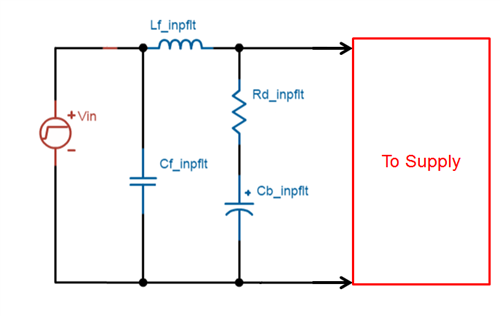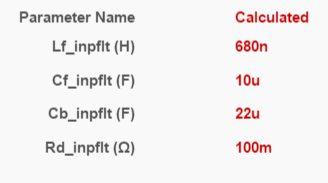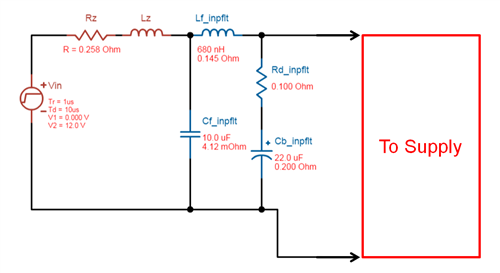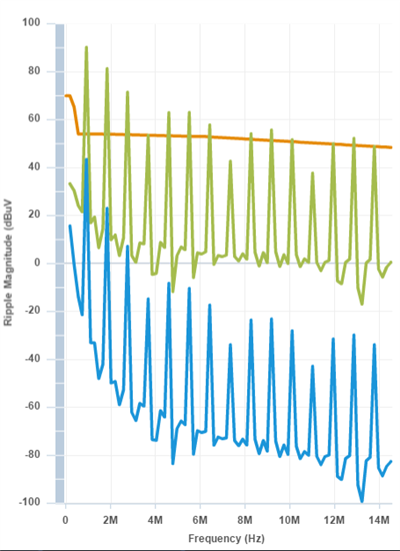SSZTAA8 march 2017 TPS54360
Let’s say you are designing a buck power supply for a combustion engine application (a lawn mower, chain saw or automobile). For this application, you know you will need to meet a Comité International Spécial des Perturbations Radioélectriques (CISPR) (or Federal Communications Commission [FCC]) electromagnetic interference (EMI) specification. There are multiple approaches to mitigating EMI, including identifying the significant EMI offenders, figuring out any coupling paths, carefully engineering your circuit layout to mitigate the interference, and adding filters and snubbers. Each of these steps takes time and is difficult to accomplish without trial and error. Furthermore, you need specialized equipment and environments to test for EMI. But for all of your troubles, there are benefits beyond passing the CISPR specification. You will be protecting any sensitive circuits from excessive input or output-voltage ripples that can compromise the operation of your supply or load.
Let’s discuss one EMI mitigation method that addresses conducted EMI noise: the use of an input filter. A power-supply input filter prevents a high-frequency voltage on the power line after passing through the power converter. You must carefully design the filter to be stable, avoid large in-rush current and avoid degrading the loop response, all while achieving a good compromise between efficiency, size and cost. The TPS54360 in a buck topology runs at 10VDC-14VDC and delivers 3.3V at the output at 2A. The circuit shown in Figure 1, created using WEBENCH® Power Designer, is the design I’ll explore in this post.
 Figure 1 TPS54360 Buck Power Supply
Circuit Example
Figure 1 TPS54360 Buck Power Supply
Circuit ExampleWho knows, you may be lucky and not require a filter. You won’t know for sure until you do some calculations. Spoiler alert! In this example, we’re not lucky.
Here are the steps to creating the input filter:
- Identify the highest noise component and the frequency at which the highest noise occurs.
- Determine how much attenuation you need to meet the noise specification.
- Select a filter type, such as undamped Inductor-capacitor, parallel damped, series damped, etc.
- Determine the output impedance and the transfer function equations for the filter type.
- Select components for the filter
(inductors, capacitors, resistors) that will accomplish these goals:
- Provides the necessary noise attenuation, particularly at the main frequency.
- Enables the power supply to remain stable.
- Does not significantly impact the loop compensation.
- Components are available off the shelf that meet cost and size targets.
- Measure the prototype for conducted noise and verify that the circuit meets the specification across all frequencies. (You know how this works … if the measurements show that the circuit doesn’t meet the specification, it’s rinse, wash and repeat, starting again at selecting the filter and components.)
To make things easier, WEBENCH Power Designer has an input filter tool that does the calculations and selects the filter type and components to meet your criteria.
Assume that the highest noise component will typically be at the switching frequency of the switch-mode power supply (SMPS). The power circuit using the TPS54360 has a switching frequency of 918kHz. You can estimate the noise or obtain the baseline noise figure at the switching frequency through measurement under worst-case operation or the highest input current, which in this case is 2.3A. See the application report, "AN-2162 Simple Success with Conducted EMI from DC-DC Converters," for more details on estimating attenuation and measurement of EMI.
It is important to understand the unfiltered circuit phase margin and gain crossover frequency, which is 60.5 degrees with a crossover at 58.8kHz.
The circuit has a whopping 90dBµV at 918kHz. At this frequency, the CISPR 25 Class 5 specification is 54dBµV. So you need a filter that will attenuate 36dBµV or more. You can also expect that additional harmonics may be well above the specification, so you will need to verify that you are meeting the specification across the spectrum of 1-100kHz and mitigate any noise above the specification across the entire range. To do so, you need to choose a filter topology. I’ll use the parallel damped filter topology since this topology addresses the attenuation, helps maintain a stable supply and meets impedance requirements.
First choose an inductance, Lf_inpflt, and then calculate the right filter capacitance, Cf_inpflt. You have to be careful in your choices, because large values of Lf_inpflt and small values of capacitance can lead to input instability and interfere with the operation of the power supply. To avoid this, use a damping capacitance, Cb_inpflt and Rd_inpflt (to reduce the output peak impedance of the filter at the cutoff frequency). See the application note, "Input Filter Design for Switching Power Supplies," for more on the calculation and design of parallel damped filters.
 Figure 2 Parallel Damped Filter
Configuration
Figure 2 Parallel Damped Filter
ConfigurationThese calculations were easy and fast, and address any stability and loop-compensation concerns using WEBENCH Power Designer’s input filter design tool. Using the Fourier series of the input current waveform and the impedance of Cin, Power Designer calculated the values for the input filter shown in Figure 3.
 Figure 3 WEBENCH Power Designer’s
Calculated Filter Component Values
Figure 3 WEBENCH Power Designer’s
Calculated Filter Component ValuesThe tool provides the ability to adjust the input line impedance, Rz and Lz, in order to adjust the filter to board layout and circuit conditions. Figure 4 shows the filtered circuit with its estimated line impedances.
 Figure 4 WEBENCH Power Designer
Calculated Damped Input Filter Circuit
Figure 4 WEBENCH Power Designer
Calculated Damped Input Filter CircuitFigure 5 gives you the full power supply circuit example with the added input filter. Power Designer will let you add or remove the input filter and explore the circuit and filter behavior to make any adjustments you desire.
 Figure 5 Final TPS54360 Buck Power
Supply Circuit with Input Filter
Figure 5 Final TPS54360 Buck Power
Supply Circuit with Input FilterThe crossover gain and phase margin are unchanged by the addition of the filter. The EMI conducted noise is now below the CISPR standard across all frequencies. In Figure 6, the orange line is the CISPR standard, the green line is the calculated noise before the filter addition, and the blue line is the calculated noise after the filter addition.
 Figure 6 Ripple Magnitude vs. Frequency
CISPR 25, before and after Input Filter
Figure 6 Ripple Magnitude vs. Frequency
CISPR 25, before and after Input FilterAs you can see, WEBENCH Power Designer cannot just help you select and design your power-supply circuit and explore circuit performance. It also provides advanced features like EMI input filter design to help you address issues like conducted EMI noise, and low-dropout regulator (LDO) attach to reduce switcher-induced noise in your power system.
You can see a live demonstration of the input filter design for EMI with WEBENCH Power Designer in TI’s booth, No. 701, at the Applied Power Electronics Conference (APEC) March 26-30 in Tampa, Florida.
Additional Resources
- Open the design example for the TPS54360 with VIN = 10-14V, VOUT = 3.3V and IOUT = 2A, with a parallel damped filter in WEBENCH Power Designer.
- For additional considerations for power-supply layouts, read the technical article, "Optimizing layout for synchronous buck converter."